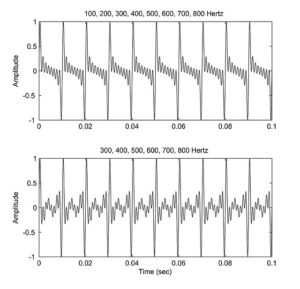Harmonics Distortion and Harmonic Effect in Power System.
In this article we are going to discuss about the harmonics distortion and harmonic effect in power system. We will know in detail about behavior of harmonics distortion and harmonic effect on different kind load.

Harmonics Distortion and Harmonic Effect in Power System.
Harmonic distortion is not a new phenomenon on power system. The impact of harmonics on the quality of electrical power continues to be a critical concern. Electrical power system harmonic problems are mainly due to the substantial increase of non-linear loads due to technological advances, such as the use of power electronic circuits and devices in AC/DC transmission links, or loads in the control of power system using power electronics or microprocessor controllers. Prior to the advent of power semiconductors, the main sources of wave form distortion were electric arc furnaces, the accumulated effect of florescent lamps and to a lesser extent electrical machines and transformers. These kind develop some harmonics distortion and harmonic effect in power system.
Any periodic, distorted wave form can be expressed as a sum of sinusoidal. When a waveform is identical from one cycle to the next, it can be represented as a sum of pure sine wave in which the frequency of each sinusoidal is an integer multiple of the fundamental frequency of the distorted wave. This multiple is called a harmonic of the fundamental. Or in other words, any periodic non-sinusoidal waveform can be resolved into a fundamental wave of the same frequency and several other sinusoidal wave forms of higher frequency order known as harmonics.
The sum of sinusoids is referred to as a Fourier series. Fourier series concept is universally applied in analyzing harmonics problem. The system can now be analyzed separately at each harmonic. Effect of each harmonic is analyzed mathematically by applying the rules of circuit’s analysis of sinusoidal periodic functions. The effect of original non-sinusoidal waveform on the circuits is predicted by summing up the effect component sinusoidal waveforms by using superposition theorem. Finding the system response of a sinusoid of each harmonic individually is much more easily compared to that with the entire distortion wave forms. Often, only the magnitudes of the harmonics are of interest.
When both the positive and negative half cycles of waveforms have identical shapes, the Fourier series contains only add harmonics. This further simplifies power studies because most common harmonic-producing devices look the same to both polarities. Thus, the presence of even harmonics shows that there is something wrong-either with the load equipment or with the measurement. There are exceptions to this such as arc furnaces when the arc is random. Higher-order harmonics (above the range of the 25th) may cause interference with low-power electronic devices, but are usually not damaging to the power system. Therefore, the higher order harmonics are normally negligible for power system analysis. It is also difficult to have sufficiently accurate data to model power systems at these frequencies. A common exception to this occurs when there are system resonances in the range of frequencies. These resonances can be excited by notching or switching transients in electronic power converters.

When electricity is generated by the utility the shape of the voltage waveform is sinusoidal. Traditional loads such as incandescent lighting, and heaters connected to a sinusoidal voltage draw current which is also sinusoidal. When the shape of the current waveform mirrors the shape of the current waveform mirrors the shape of the applied voltage. Both are sinusoidal harmonics are absent. Harmonic distortion is caused by non-linear devices in the system. A non-linear devices is one in which the current is not proportional to the applied voltage. The load in which the current waveform does not resemble the applied voltage waveform. This may be due to a number of reasons, for example, the use of electronic switches that conduct load current only during a fraction of the power frequency period. Therefore, one can also say non-linear loads as those loads in which Ohm’s law cannot describe the relation between V and I . Among the most common non-linear loads in electrical power systems are all types of rectifying devices like those found in power converters, uninterruptible power supply units and arc devices such as electric arc furnaces and fluorescent lamps.
Responsibility for Harmonic Control
For remove to harmonics distortion and harmonic effect in power need to be responsibility of harmonic control . These are some method of harmonic control.
- The control over the amount of harmonic current injected into the system takes place at the end-use application.
- Assuming the harmonic current injection is within reasonable limits, the control over the voltage distortion is exercised by the utility which has the control over the system impedance.
Power System Quantities under No sinusoidal Conditions
Power system that are conceived to operate at the fundamental frequency are susceptible to erroneous behavior as more and more non-linear loads are connected to the system. Power system quantities such as power ( reactive , active apparent) power factor , and phase sequences are defined for the fundamental frequency context in a pure sinusoidal condition , In the presence of harmonic distortion , The power system no longer operates in a sinusoidal condition , and therefore , may of the simplifications used for the fundamental frequency analysis do not apply.
Harmonic Phase Sequences
For control harmonics distortion and harmonic effect in power system it is must be check of harmonic phase sequences. The method of symmetrical components can be employed for analysis of the system’s response to harmonic currents provided the fundamental assumptions are not violated. The method of symmetrical components was proposed by fortes cue. According to fortes cue, three unbalanced phases (current or voltage) of a three-phase system can be resolved into three balanced system of phases which have certain symmetry. The balanced set of components are:
- Positive sequence set
- Negative sequence set
- Zero sequence set
Total Harmonic Distortion in Power System.
The total harmonic distortion THD is a measure of the effective value of the harmonic components of a distorted waveform. It is the potential heating value of the harmonics relative to the fundamental. Although many of today’s test and measuring instruments can provide THD values, it is still important to understand the calculation that give THD . This index can be calculated for either voltage or current. These kind need to measure harmonics distortion and harmonic effect in power system.
Harmonics distortion and harmonic effect in power system In Different kind load
Harmonic sources from commercial load
Commercial establishments such as office, departmental stores, hospitals etc. Have efficient fluorescent lighting with electronic ballasts, variable speed drives for the heating. Ventilation, and air conditioning (HVAC) loads, elevator drives, and sensitive electronic equipment fed by switch-mode power supplies. These electrical loads at the commercial establishments are known as commercial loads. These commercial loads produce harmonic currents. Depending on the diversity of the load the small harmonic currents produced by these may add or cancel each other.
Fluorescent Lighting
Fluorescent light are a popular choice in residential and commercial sector because of its energy savings. Fluorescent lights are discharge lamps and require a ballast. The ballast provide a high initial voltage to initiate the discharge for the electric current to flow between two electrodes. Once the discharge is established, the ballast has to quickly reduce the current to a given level to maintain the specified lumen output.
There are two types of ballasts:
1 Magnetic ballast
2 Electronic ballast
Harmonic sources from Industrial loads
There is widespread applications of non-linear loads in modern industrial facilities. Power line harmonics are created when non-linear loads draw non-sinusoidal current from a sinusoidal voltage source. Non-linear loads can result in high neutral currents in the three-phase system. These harmonics can result in neutral current that exceeds the individual phase current. These loads inject harmonic currents into the power system, causing harmonic distortion in the voltage. The main tendency of harmonic currents is to flow from the harmonic producing load to the power system source.
Electric drives
The system employed for motor control are called drives. The drives employing electric motors are known as electric drives. Motor control is required for a large number of industrial and commercial application such as transportation system, rolling mills, fans, pumps, HVAC etc.
DC motors have been used in variable speed drives for a long time. The variable control characteristics of DC motors have contributed to their extensive use in industry and electric traction. The method of speed control are simpler and less expensive than those of AC motors.
There are a number of different terms used to describe the AC drive, variable speed drive (VSD), variable frequency drive (VFD) and inverters; all are used but have the same meaning. The main purpose of all AC drives is to control the operation of AC motor with regard to speed and torque.
Effect of Harmonic Distortion in Power System
Harmonic currents produced by non-linear loads can interact adversely with a wide range of power system equipment, mainly transformers, capacitors and motors, causing additional losses, overheating and overloading. These harmonic currents can also cause interference with telecommunication lines and errors in protective relays and power metering. These are some reason of harmonics distortion and harmonic effect in power system. Some impact we are discussing for harmonics .
Impact on Transformers
Harmonic distortion of the current and voltage will contribute significantly to additional heating in transformers. There are increased transformer losses when the load current includes harmonic components.
Harmonic impact on capacitors
The harmonic current can cause excessive stress in components, especially capacitors connected directly to the supply. Problems involving harmonics often show up at capacitor banks first. As the supply impedance is normally inductive, the network impedance increases with the frequency whereas the impedance of a capacitors decreases.
Harmonic impact on Motor
Harmonic current will produce their own alternating magnetic flux that will at different instances add to or subtract from that of the basic current. This will produce vibration in the motor and overheating of the motor while producing no mechanical power.
Harmonic Impact on Telecommunication
Telecommunication systems often give you the first clue to a harmonics problem. The presence of harmonic currents or voltage produce magnetic and electric fields that may impair the satisfactory performance of communication systems susceptible to the disturbance by virtue of their proximity.
Harmonic Impact on metering Equipment and Relays
Power system harmonics can cause errors in electric meter readings. Since induction discs in watt-hour meters are designed to monitor non-distorted fundamental current , harmonic currents from non-linear loads will cause measurements errors, usually resulting in the consumer paying more for electricity than if the same rms current being drawn was sinusoidal.
Harmonics Effect on Equipment and devices
These are some harmonic effect in equipment and device .. It will do easy to understand of above topic which is harmonics distortion and harmonic effect in power system.
|
Equipment/Device |
Effect |
|
Capacitor banks |
Overheating, insulation breakdown |
|
Transformers and Reactors |
Overheating |
|
Motors |
Increase noise, Overheating, additional vibrations. |
|
Telecommunication lines |
Noise |
|
Lines |
Overheating |
|
Electronic devices |
Overvoltage, under voltage, Wrong pulses, Flickering screens. |
|
Protective Equipment |
False tripping, No tripping. |

Harmonic Distortion Evaluations
Harmonic currents produced by nonlinear loads such as arcing devices, VSD, discharge lamps etc. can interact adversely with the utility supply system, giving rise to voltage and current harmonic distortion in many locations in the system. Therefore, to limit both voltage and current harmonic distortion, harmonic current injection from consumer end should be limited.
These are Harmonics distortion and harmonic effect in power system . If you will find any incorrect in above article please comment below in comment box.